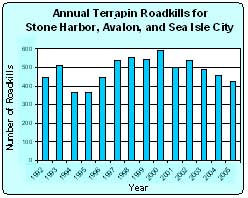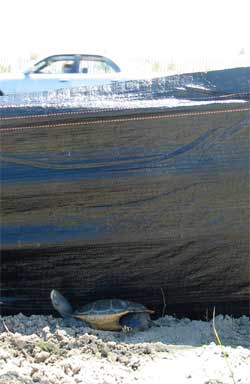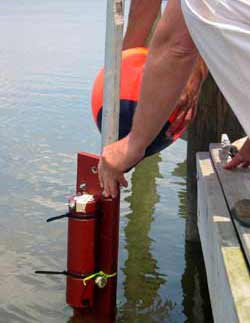Abstracts of Papers
Presented by Wetlands Institute staff at the
Atlantic Estuarine Research Society Spring 2006 Meeting, March 9–11, 2006
The Academy of Natural Sciences, Philadelphia, Pennsylvania
Reducing Diamondback Terrapin Road Mortality:
Conserving Turtles by Installation of Roadside Barrier Fencing
Benjamin K. Atkinson1, 2 and Roger C. Wood1
![]()
1Wetlands Institute, 1075 Stone Harbor Boulevard, Stone Harbor, NJ 08247, USA
2Chelonian Research Institute, 402 South Central Ave., Oviedo, FL, 32765

![]() Every year, hundreds of gravid diamondback terrapins (Malaclemys terrapin terrapin) are killed by motor vehicles on roads crossing or adjacent to salt marshes along the Atlantic coast of southern New Jersey. A pilot study, conducted in Sea Isle City, New Jersey, during the summer of 2004 indicated that temporary silt fencing can provide an effective barrier that prevents terrapins from wandering onto heavily trafficked roads while searching for nest sites. In view of these encouraging preliminary results, a large-scale barrier fencing project was undertaken during the summer of 2005. Roughly 0.9 kilometers of silt fencing was installed along either side of Stone Harbor Boulevard (1.77 kilometers total) in the vicinity of the Wetlands Institute. Road patrols over the previous decade had established this area as a “hot spot” for terrapin road mortality. Forty-one terrapin roadkills were documented along this stretch of causeway in 2004. Only six roadkills were recorded when the same section of road was bordered by barrier fencing during the 2005 terrapin nesting season. Thus, there was a net reduction of 35 road kills (85.4%) between the summers of 2004 and 2005.
Every year, hundreds of gravid diamondback terrapins (Malaclemys terrapin terrapin) are killed by motor vehicles on roads crossing or adjacent to salt marshes along the Atlantic coast of southern New Jersey. A pilot study, conducted in Sea Isle City, New Jersey, during the summer of 2004 indicated that temporary silt fencing can provide an effective barrier that prevents terrapins from wandering onto heavily trafficked roads while searching for nest sites. In view of these encouraging preliminary results, a large-scale barrier fencing project was undertaken during the summer of 2005. Roughly 0.9 kilometers of silt fencing was installed along either side of Stone Harbor Boulevard (1.77 kilometers total) in the vicinity of the Wetlands Institute. Road patrols over the previous decade had established this area as a “hot spot” for terrapin road mortality. Forty-one terrapin roadkills were documented along this stretch of causeway in 2004. Only six roadkills were recorded when the same section of road was bordered by barrier fencing during the 2005 terrapin nesting season. Thus, there was a net reduction of 35 road kills (85.4%) between the summers of 2004 and 2005.
Population Demographics of The Northern Diamondback Terrapin (Malaclemys Terrapin Terrapin)
in Four Salt Marsh Creeks on the Cape May Peninsula, New Jersey
Andrew Ferreira
![]()
Terrapin Conservation Project, The Wetlands Institute, 1075 Stone Harbor Blvd., Stone Harbor, NJ, 08247
Diamondback terrapins dwell in brackish marshes along the Atlantic and Gulf coasts of the United States. In southern New Jersey, thousands of terrapins are killed every year — females are run over by vehicles during the nesting season and both sexes are drowned in commercial crab traps. During the summer of 2005, a study of terrapin size distribution and sex ratios was undertaken in four small salt marsh creeks where the surrounding area has high road mortality of nesting females. Commercial crab traps baited with fish were used to capture terrapins in the creeks. terrapins caught were microchipped if they were not previously marked. Most terrapins were caught at the mouth or headwaters of each creek. The sex ratio is slightly biased toward females, and most terrapins caught range between 9 and 13 cm in carapace length. Captures of relatively small individuals may indicate that particular creeks are populated by younger terrapins, and as they get bigger they move to bigger creeks; or crab traps may bias selectivity toward smaller individuals; or larger females are becoming scarcer due to anthropogenic mortality.

Long-Term (1995–2005) Road Mortality of Diamondback Terrapins
(Malaclemys terrapin terrapin) on the Margate/Northfield Causeway
in Atlantic County, New Jersey: Implications for Conservation
Joanne Jimenez and Roger C. Wood
![]()
Terrapin Conservation Project, The Wetlands Institute,
1075 Stone Harbor Blvd., Stone Harbor, NJ, 08247
Hundreds of gravid female diamondback terrapins (Malaclemys terrapin terrapin) are killed annually on roadways crossing and adjacent to coastal salt marshes in southern New Jersey. From 1995 through 2005, volunteers conducted a daily census of terrapin road kills on one of these roadways, the Margate/Northfield causeway near Atlantic City, New Jersey. Over this 11-year time span, 1,174 roadkills were documented along the 4.1 kilometer length of this causeway. The highest density of roadkills (46 terrapins/kilometer/year) is concentrated along a 0.85 kilometer section at the eastern end of the causeway on Pork Island. Approximately one-third (36.5%) of the annual terrapin roadkills could be prevented by installing a barrier fence along both side of this section of roadway. Experiments on other southern New Jersey salt marsh causeways have shown that barrier fences are effective at keeping terrapins off roadways while still allowing them to nest successfully.
Use of Sonic Telemetry to Determine Behavior of Northern Diamondback Terrapins
(Malaclemys terrapin terrapin) in a Southern New Jersey Salt Marsh
Madeline Renny1 and Christina Watters2
![]()
1Princeton University, Princeton, NJ, 08544
2Terrapin Conservation Project, The Wetlands Institute, 1075 Stone Harbor Blvd., Stone Harbor, NJ, 08247

![]() Because of their cryptic nature, little is known about the movements of diamondback terrapins in their typical salt marsh habitats. Sonic telemetry enables the tracking of animals that live and move underwater, such as diamondback terrapins. A small transponder tag, which sends out a unique signal, is attached to an individual terrapin. The signal is picked up by a stationary receiving device whenever the terrapin swims by. We attached transponder tags to the shells of 20 diamondback terrapins: five wild, adult females that nested on the Wetlands Institute property in southern New Jersey; five captive raised, head-started juvenile terrapins; and ten wild terrapins (1 male and 9 females, both juveniles and adults) captured in a local creek. We positioned seven stations with receiving devices and temperature loggers in marsh creeks near the Institute. The study was initiated in mid-June, while terrapins were active, and the study was ended in early December, after all of the terrapins in our area entered hibernation for the winter. We documented overall patterns of terrapin activity and movement, relating to location, temperature, tides, and time of day based on this season’s recorded data. Of particular interest is that individual terrapins have distinctive behavioral patterns.
Because of their cryptic nature, little is known about the movements of diamondback terrapins in their typical salt marsh habitats. Sonic telemetry enables the tracking of animals that live and move underwater, such as diamondback terrapins. A small transponder tag, which sends out a unique signal, is attached to an individual terrapin. The signal is picked up by a stationary receiving device whenever the terrapin swims by. We attached transponder tags to the shells of 20 diamondback terrapins: five wild, adult females that nested on the Wetlands Institute property in southern New Jersey; five captive raised, head-started juvenile terrapins; and ten wild terrapins (1 male and 9 females, both juveniles and adults) captured in a local creek. We positioned seven stations with receiving devices and temperature loggers in marsh creeks near the Institute. The study was initiated in mid-June, while terrapins were active, and the study was ended in early December, after all of the terrapins in our area entered hibernation for the winter. We documented overall patterns of terrapin activity and movement, relating to location, temperature, tides, and time of day based on this season’s recorded data. Of particular interest is that individual terrapins have distinctive behavioral patterns.